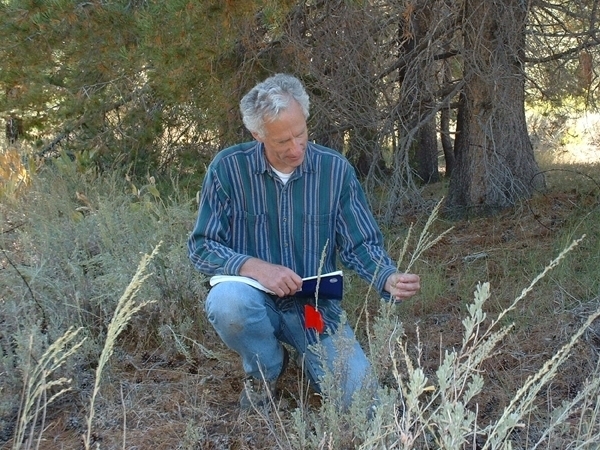- Author: Kathy Keatley Garvey
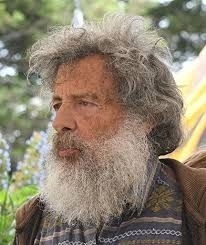
On Friday, Aug. 26, he met with success. He spotted four within half an hour.
It all began with his stroll through the UC Davis Arboretum and Public Garden, "where construction at Wyatt Deck was finally completed and the paths have been reopened," he related in a group email.
"It was my first time there in about 3 weeks. As usual, I scoped out the big Asclepias speciosa clone and found...nothing." He then crossed over Arboretum Drive to the Environmental Horticultural gardens where he knew of another small clone of A. speciosa. "By now it was 4:30 p.m. and the area was in dappled light and shade--and there were two brilliantly fresh-looking male monarchs chasing each other in the trees above the milkweed!"
"I looked over the plants for evidence of larval feeding and found absolutely none; I can't believe they were 'born' there despite being so brilliantly fresh-looking. I then walked west on Arboretum Drive, intending to turn north toward Mrak Hall, when an old, worn male monarch flew directly in front of me near eye level. It was now 4:50.
"As I went to turn toward Mrak (Hall) a fresh-looking one--sex undetermined--was cruising up in the trees near the bridge. I believe I saw four different individuals within half an hour. That's almost as many as I've seen in Davis all year."
Then, on Aug. 29, Shapiro ventured to north Davis where Professor Louie Yang of the UC Davis Department of Entomology and Nematology and collaborators had planted several dozen narrow-leaf milkweed, Asclepias fascicularis, several years ago for their research projects. "Nearly all the plants are in seed; I only found three still in bloom," Shapiro said. "And one had a beautiful, fresh-looking male monarch nectaring at it at 11.55 a.m. I didn't try inspecting all those plants but on casual inspection, I noted no evidence of larval feeding, nor pupae nor pupal exuviae."
That's good news on The Monarch Front.
Shapiro's colleague and former doctoral student Matt Forister, the McMinn Professor of Biology at the University of Nevada, Reno (UNR), alerted him to more good monarch news: "They're passing through Reno with increasing frequency. I am personally seeing ~1 per day now. All stopping for nectar, and heading your way, Art. Looks like the production in the desert has been good." (See latest research by Forister and colleagues on "Milkweed Plants Bought at Nurseries May Expose Monarch Caterpillars to Harmful Pesticide Residues," published in the science journal Biological Conservation.)
As you may know, Shapiro has been studying the butterfly populations at 10 sites in Central California for 50 years and maintains a research website, Art Shapiro's Butterfly Site, aka Art's Butterfly World.
The North American Butterfly Monitoring Network (NABA) website praises his work as "the longest continually running butterfly monitoring project in the world":
"Art Shapiro began monitoring 10 transects in 1972 and has been conducting bi-weekly monitoring of those sites ever since. He also monitors an additional site as part of NABA's Seasonal Count Program! Art's program is the longest continually running butterfly monitoring project in the world, predating even the British Butterfly Monitoring Scheme."
Elsewhere in Davis, Bohart Museum of Entomology associate Greg Kareofelas has seen monarchs in his Davis backyard three times this year: May 6, May 11, and in early June. "A couple of days ago, in the Inner Coast Range, Glenn county I saw nine or ten adults and that many larvae."
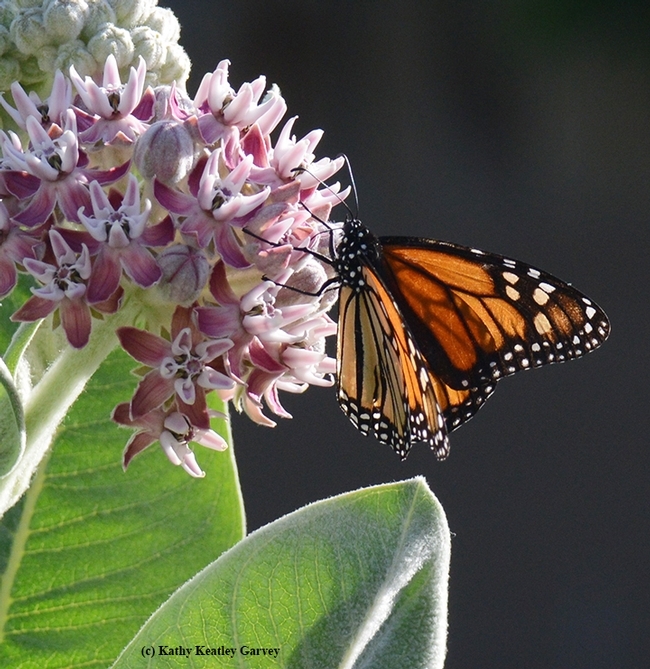

- Author: Kathy Keatley Garvey

California's 2021 western monarch Thanksgiving count, directed by the Xerces Society of Invertebrate Conservation, recorded 250,000 overwintering monarchs, as compared to a mere 2000 in 2020.
Executive producer and host Ira Flatow of Science Friday set out to "unpack the news" for his listeners. On Feb. 4, he interviewed community ecologist Louie Yang, professor, UC Davis Department of Entomology and Nematology, and a faculty member of the Center for Population Biology. (Listen to the interview, 'How Long Will California's Butterfly Boom Last?')
"OK, so how did the population bounce back so dramatically?" Flatow asked. "And is this number a blip on the radar or the start of better times for the beleaguered butterfly? Here to help us unpack the news, Dr. Louie Yang, a professor and ecologist at the Department of Entomology and Nematology, UC Davis."
"It seems reasonable to say that an increase of this magnitude would probably require a series of fortunate conditions throughout the breeding season that would sustain population growth across multiple generations," the UC Davis professor told him, adding "What we've seen is a long-term trajectory of declining populations, even before the recent population variability."
Yang focuses his research on "understanding the seasonal dynamics of milkweed-monarch interactions. How do monarch caterpillars develop on their milkweed host plants? And what are the conditions that allow them to develop well and survive to adulthood? And what are the conditions that cause lower survivorship?"
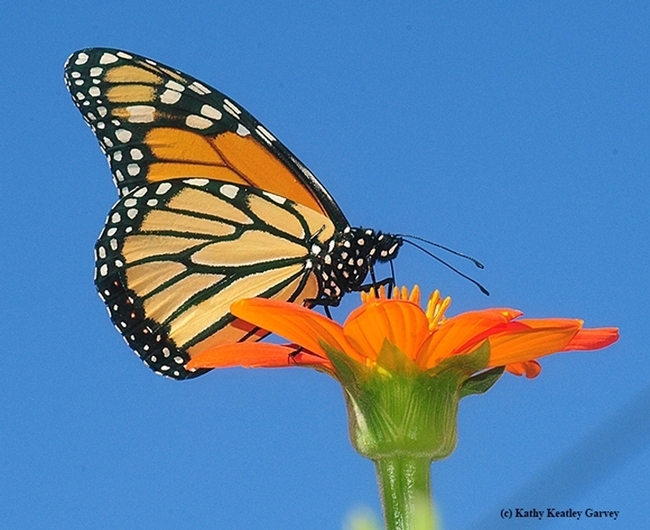
Bottom line. The 100-fold increase in monarch population may or may not be a sign of what's to come. As Yang said: "So we shouldn't be complacent or assume that populations will always bounce back from low densities...I think a lot of folks are breathing a sigh of relief that the population has increased as much as it has over the past year. And I think we all share that sense of relief and joy that the population has increased. But also, there is that note of caution that there is a lot about the dynamics of this population that we don't yet understand and we're still working on."
Social media responses to the podcast included: "Great podcast! I learned even more today about the timing of milkweed availability and monarch eggs--now I understand why late season eggs have a higher percentage of survivorship. Everyone should listen to Professor Yang's interview. It's just a little over 10 minutes, but packed full of information."
Louie Yang
Yang, who joined the UC Davis faculty in 2009, holds a bachelor's degree in ecology and evolution from Cornell University, (1999) and a doctorate from UC Davis (2006).
Lauded for his advising and teaching skills, in 2018 Yang received an international award from NACADA, also known as the Global Community for Academic Advising. He co-founded and co-directs the campuswide program, Research Scholars Program in Insect Biology, with UC Davis distinguished entomology professor Jay Rosenheim and professor Joanna Chiu, vice chair of the UC Davis Department of Entomology and Nematology,
Yang, born in Australia but raised in West Virginia, says on his website: "When I was in elementary school, I wanted to be a pet shop owner. In high school, I wanted to be a veterinarian. As a college freshman, I thought I wanted to make nature documentary films. As it turns out, I was really interested in ecology and evolution. After I graduated, I traveled and started a PhD. I've been faculty at the University of California, Davis since 2009. I'm still learning new things all the time."
His current research?"I am working to develop a temporally explicit view of ecology that examines how ecological communities combine complex, coordinated and changing interactions over time. I am particularly interested in the effects of climate change on species interactions, community responses to strong perturbation events, phenological cues and phenological shifts, and seasonal changes in the nature and outcomes of species interactions. I study several different organisms in a wide range of ecological communities, each of which contributes to a broader understanding of how species interactions change over time." (See The Yang Lab website.)
So, in today's Bug Squad, a brief spotlight on Professor Yang:
Question: "How long have you been doing scientific research on monarchs?"
Answer: "I visited the overwintering monarch population at the Coronado Butterfly Preserve in Santa Barbara in 2006, and I started doing research with them shortly afterwards."
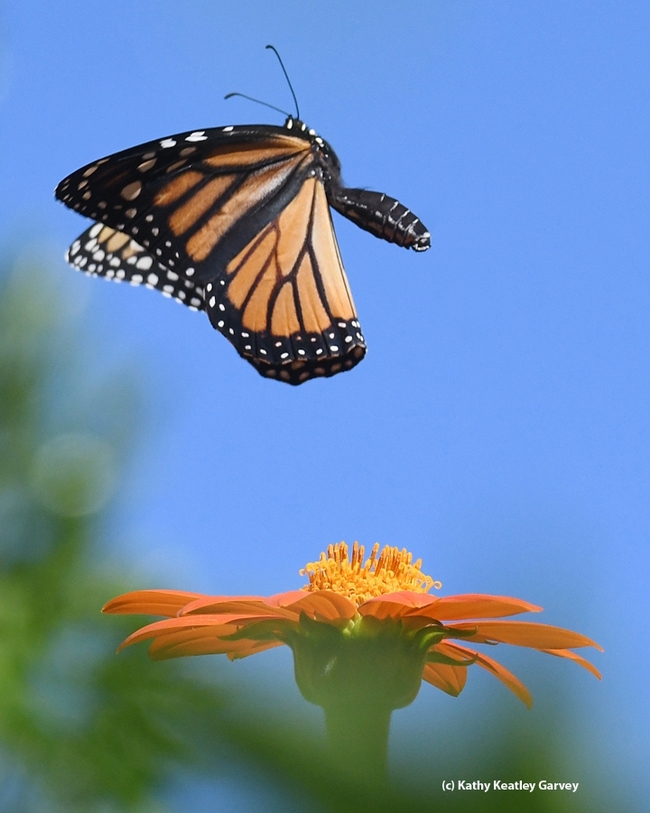
A: "Because monarch can travel long distances, it struck me that when they leave their overwintering grounds they might not have very good information about the environmental conditions at their destination. It seems like this lack of information could create the potential for phenological mismatches between the monarch and its host plant."
Q: "What are some of the results?"
A: "Broadly, our results indicate that western monarchs show “seasonal windows of opportunity”--periods in the year with increased developmental prospects. These seasonal windows are constrained by a combination of abiotic (i.e., climatic), bottom-up (i.e., host plant-related), and top-down (i.e., natural enemies-related) factors. In our region, we see two windows of opportunity (late spring/early summer and late summer/early fall) separated by a 'mid-summer slump' on their most common host plant, narrow-leaved milkweed (Asclepias fascicularis). However, plant traits matter: for example, the defensive traits of showy milkweed (Asclepias speciosa) tend to increase across the season, and the monarchs on this species only seem to show one early season window. On showy milkweed, success in the late season window seems to be constrained by host plant defensive traits. Our work has also shown that these seasonal windows appear to be constrained by different factors in the early and late part of each breeding season, and that climatic variation strongly shapes the timing and relative importance different limiting factors."
Q: "What is the role of tropical milkweed, Asclepias curassavica, in monarch conservation?"
A: "I've not studied this in detail myself, but there is a concern that tropical milkweed could change the life history of western monarchs and expose them to more diseases. Unlike our native milkweeds, tropical milkweeds don't senesce during the winter. They continue to grow year-round and are very attractive to monarchs. As a result, this non-native host plant might encourage monarchs to continue breeding longer into the winter than the would normally. In addition, because these milkweeds persist year after year, there are concerns that they can build up higher densities of Ophryocystis elektroscirrha spores, exposing monarch caterpillars to a greater risk of disease."
Q: "What can area residents do to help in monarch conservation?"
A: "I'd encourage folks interested in helping monarch conservation to learn as much as they can about the many and complex factors that can affect monarch populations. Recent variability in the western monarch population illustrates the potential for rapid declines and resilience in this population, but it also shows us the limits of our current understanding about the ecology of western monarchs. Ecology ain't rocket science--it is much more complicated. There is a lot we don't yet know, but there is also a lot that has become clearer over time. We probably know enough now to say that the combined and interactive effects of climate change, land use change, novel environmental chemicals and the global transport of organisms have played a role in the decline of monarch butterflies and many other insects. Scientists will continue working to understand this in more detail, but working now to limit those drivers makes sense."
Q. "What milkweed do you recommend folks should plant in Central California?"
A. "I'd encourage folks to learn about and cultivate the species of milkweed that grow wild in their local area. California has a remarkable diversity of milkweed species, and each occupies a unique niche. Websites like iNaturalist can help folks learn about the species that grow naturally in their area. Visiting established populations of wild milkweed will give folks a sense for the specific habitats that these milkweeds need to survive and thrive. The Xerces Society has also compiled some great information how and where to cultivate milkweed in California." (See Xerces Society website.)
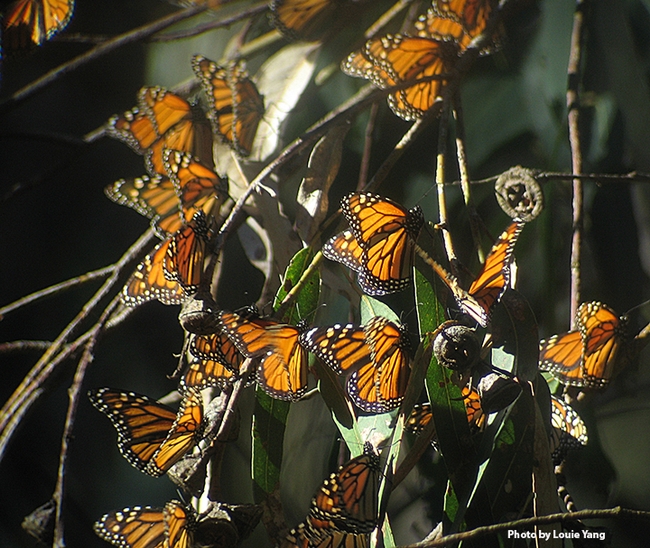
- Author: Kathy Keatley Garvey
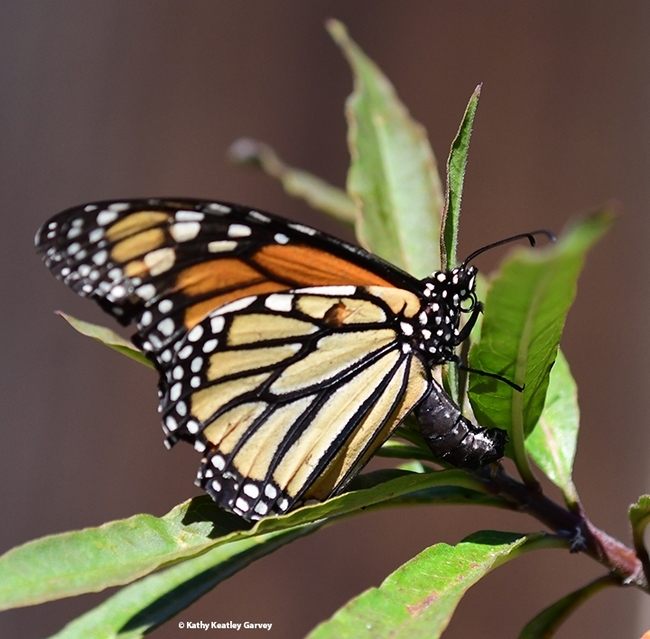
And how long misinformation can linger...
Take the news about the overwintering 250,000 monarchs recorded along the California coast in the Western Monarch Thanksgiving Count spearheaded by the Xerces Society for Invertebrate Conservation. That's more than a 100-fold increase from the previous year.
Butterfly guru Art Shapiro, a UC Davis distinguished professor of evolution and ecology who has been monitoring butterfly populations in Central California since 1972--and maintains a research website at https://butterfly.ucdavis.edu--wants to know where they came from. He acknowledges he does not know, nor does anyone else. Yet.
Lynn Kimsey, director of the Bohart Museum of Entomology and a UC Davis distinguished professor of entomology, says we shouldn't consider the population increase a trend, that it's still too early to figure out what's going on.
Says Bohart associate Greg Kareofelas: "I think it is hopeful, but we will not know for sure until 5 or 10 years have gone by. One year is not a trend."
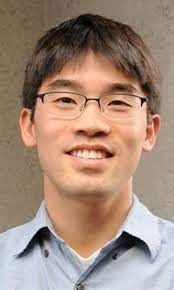
- "It is great to have more breathing room, but we're not out of the woods yet, in terms of conservation. The current population is still < 5% of our estimates from the 1980's and has only been that large for one year."
- "When populations reach unprecedented sets of conditions (in this case, lower overwintering numbers than we had ever seen before, from 2018-2020), we should expect the unexpected. And one thing to emphasize is"
- "We expect large fluctuations in abundance of butterflies and many other insect species. We need to manage for resilience, because we probably won't be able to understand every crash or rebound." (See her UC Davis seminar)
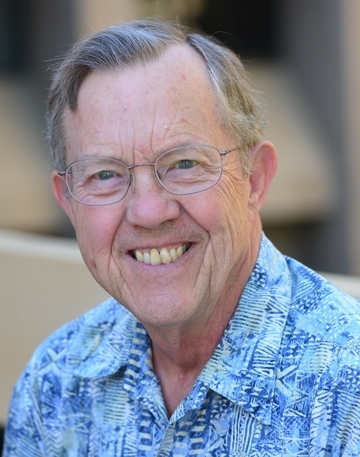
But a key point is this: "There are NOT two populations of the monarch in North America," says migration expert and monarch scientist Hugh Dingle, emeritus professor, UC Davis Department of Entomology and Nematology. "The population is all one and the butterflies from all over North America mix in Mexico during the winter diapause. The monarchs breeding in the west (of the Rockies) have at least two (and probably three) migration routes in the fall--one is to the California coast, one is down the Colorado River Valley into Mexico, and the probable third is east of the Great Salt Lake and west of the Wasatch down through eastern Arizona and into Mexico. Sample sizes are small for the third route which is why it is only probable. Also genetic data going back 50 years shows that the North American population is all one, that is, work by Walter Eanes and others including recent molecular genetics studies!"
The western migration routes are outlined in Dingle et al. Biological Journal of the Linnaean Society 85:491-500 (2005), and for various evolutionary changes in monarch migration and correlated characters see Freedman, Dingle, et al. B. J. Linn. Soc. 123:265-278 (2018), Animal Migration 5:61-73 (2018), and the Proceedings of the National Academy of Sciences (PNAS) 117: 28887-28893(2020) and references therein.
Commented Dingle: "The old saw about two North American populations is a good example of once something gets into the literature--or into the public domain-- it becomes exceedingly difficult to correct."
Now scientists are trying to figure out what contributed to the increase in the population. And where they came from.
Remember back in 2019 when Shapiro declared that the monarch population is on life support?
Hold on...
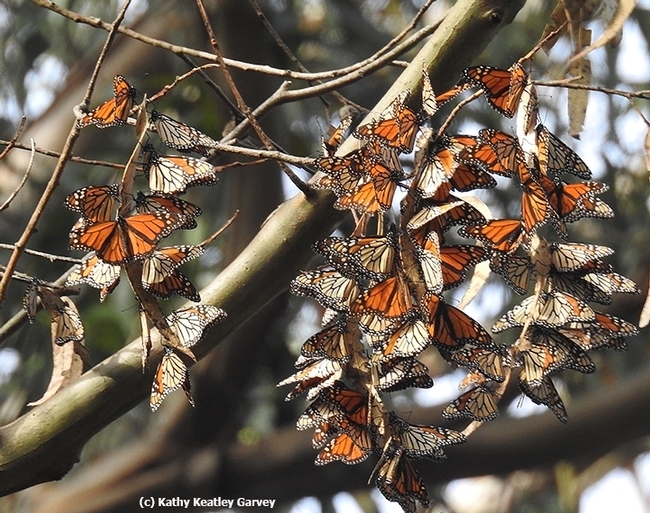
- Author: Kathy Keatley Garvey
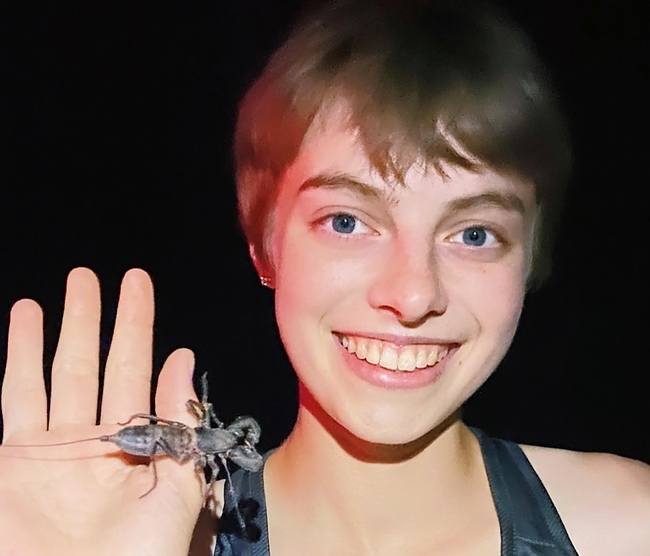
Erdosh, 21, an undergraduate entomology major and president of the UC Davis Entomology Club, is passionate about bugs. Well, make that passionate about arthropods. Well, make that passionate about "all arthropods on the planet."
Part One of the two-segment interview is at https://cbsloc.al/3G81QaT.
Billed as "bringing bugs to the masses," the program explored critters such as a Madagascar hissing cockroach, an Atlas moth caterpillar, an Australian stick insect, and a rain forest mantis.
More than 22,000 fans follow her Instagram account, @gwentomologist, where she uploads educational and entertaining posts, illustrated with her incredible macro images.
"The main point of my page is to raise awareness for conservation of insects," Erdosh told Williams. Second point: to help folks overcome their fear of bugs by seeing their beauty and peculiarities.
Erdosh showed insects from the Bohart Museum of Entomology, as well as insects being reared by her friends.
Holding an Atlas caterpillar, Erdosh told the Good Day Sacramento reporter: "This is going to become the largest moth in the world."
Erdosh then showed Williams the massive frass (feces), the size of a raisin.
In a classic quote of the day,Williams deadpanned: "It has no problem with bowel movements."
That prompted one of the Good Day Sacramento anchors to quip: "When I woke up this morning I would have bet big money I was not going to see caterpillar poop here today but here we are."
Erdosh is an invited member of the UC Davis Research Scholars Program in Insect Biology (RSPIB), and a researcher in the laboratory of community ecologist Louie Yang, a professor in the UC Davis Department of Entomology and Nematology. She recently received a UC Davis Provost's Undergraduate Research Fellowship to study whether ambient smoke from California's wildfires hinders an insect's ability to locate food.
Gwen knew at age 12 that she wanted to become an entomologist. Her career plan: to receive a doctorate in entomology and join academia as a professor and researcher. She's off to a great start! At age 16, she interned in the lab of Jason Dombroskie at Cornell University.
And quite appropriately, Gwen Erdosh sports a collection of insect-themed T-shirts. The one she wore on the Good Day Sacramento program: a T-shirt lettered with "Wait, I See a Bug!"
(See "The Amazing World of 'Gwentomologist' Gwen Erdosh" on the Dec. 23, 2021 Bug Squad blog.)
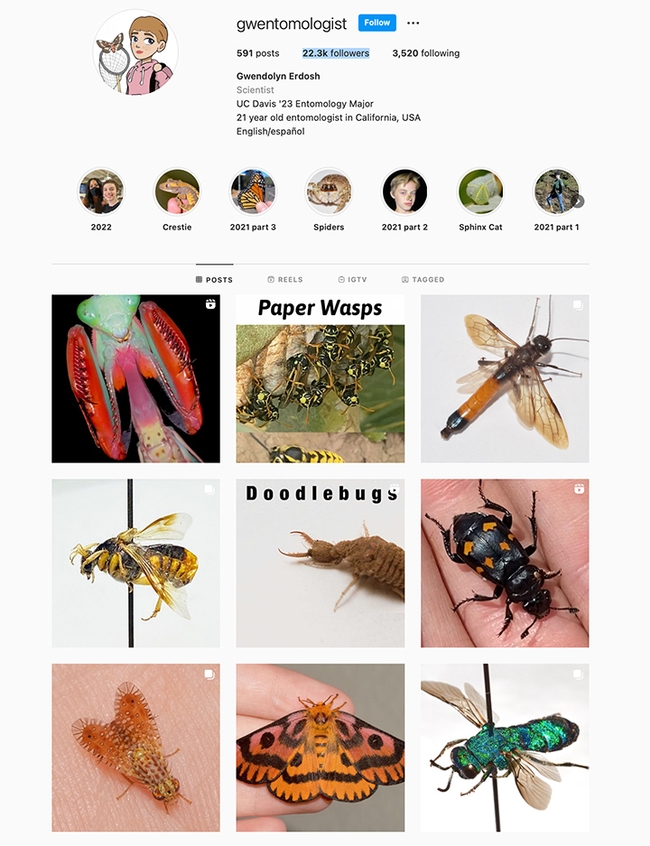
- Author: Kathy Keatley Garvey
They say good news comes in threes.
Sometimes it comes in fives!
Congrats to the five UC Davis Department of Entomology and Nematology faculty members for their outstanding academic achievements.
- Molecular geneticist and physiologist Joanna Chiu, vice chair of the department, was recently promoted from associate professor to full professor
- Community ecologist Louie Yang, promoted from associate professor to full professor
- Community ecologist Rachel Vannette, promoted from assistant professor to associate professor (with tenure)
- UC Cooperative Extension apiculturist Elina Lastro Niño, honey bee scientist and educator, promoted from assistant to associate specialist
- Ecologist Richard "Rick" Karban, professor, selected to the high campus honor of UC Davis distinguished professor.
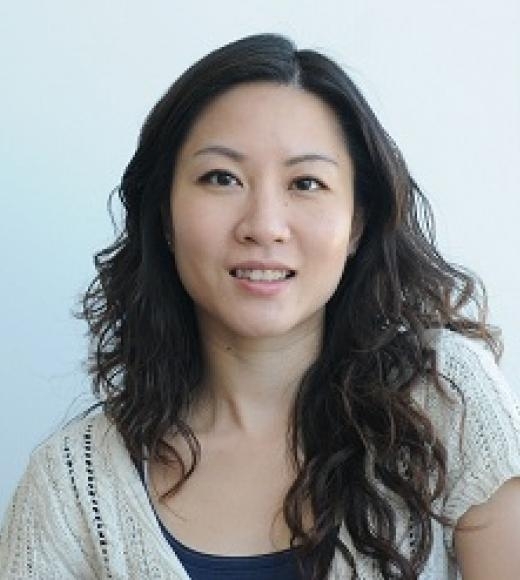
Professor Chiu, who serves as the vice chair of the UC Davis Department of Entomology and Nematology, joined the faculty in 2010. She centers her research on molecular genetics of biological timing and posttranslational regulation of proteins. She uses animal models including Drosophila melanogaster and mice to study the mechanisms that regulate circadian and seasonal physiology and behavior. Major grants from the National Institutes of Health and the National Science Foundation fund her biological rhythms research. In addition to her research in biological rhythms, Chiu also aims to leverage her expertise in genomics to address key issues in global food security.
In 2019, Chiu was named one of 10 UC Davis Chancellor's Fellows, an honor awarded to associate professors who excel in research and teaching.
Chiu and Yang co-founded and co-direct (with Professor Jay Rosenheim) the campuswide Research Scholars Program in Insect Biology, launched in 2011 to provide undergraduates with a closely mentored research experience in biology. The program crosses numerous biological fields, including population biology; behavior and ecology; biodiversity and evolutionary ecology; agroecology; genetics and molecular biology; biochemistry and physiology; entomology; and cell biology. The goal is to provide academically strong and highly motivated undergraduates with a multi-year research experience that cultivates skills that will prepare them for a career in biological research. (See more on UC Davis Department of Entomology website.)
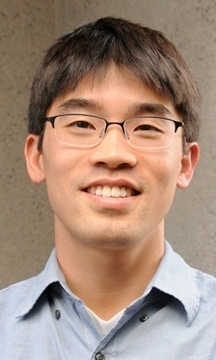
Professor Yang, who joined the UC Davis entomology faculty in 2009, was named a UC Davis Hellman Fellow in 2012. The Hellman Family Foundation contributes funds to support and encourage the research of promising assistant professors who exhibit potential for great distinction in their research. In 2013, he received a prestigious National Science Foundation Faculty Early Career Development Award of $600,000.
Yang won the 2018 Outstanding Faculty Academic Advising Award from NACADA, also known as the Global Community for Academic Advising; and the 2017 Faculty Advisor Award of Excellence in NACADA's Pacific Region 9, comprised of California, Nevada and Hawaii.
Yang says of the research underway in his lab: “We study how species interactions change over time. We apply a diversity of approaches and perspectives to a diversity of systems and questions. We do experimental community ecology. We also use observational methods,meta-analysis, conceptual synthesis, ecosystem perspectives, and theoretical models. We like data, and we like learning new things.” (See more on UC Davis Department of Entomology website.)
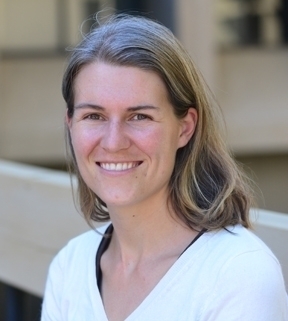
Associate professor Vannette, a member of the UC Davis entomology faculty since 2015, received a Hellman Fellowship grant in 2018 and a National Science Foundation Faculty Early Career Development Award in 2019 to study microbial communities in flowers and a National Science Foundation grant to support work on solitary bee microbiomes.
Of her research, Vannette says: “All plants are colonized by microorganisms that influence plant traits and interactions with other species, including insects that consume or pollinate plants. I am interested in the basic and applied aspects of microbial contributions to the interaction between plants and insects. I also use these systems to answer basic ecological questions, such as what mechanisms influence plant biodiversity and trait evolution.”
“The Vannette lab is a team of entomologists, microbiologists, chemical ecologists, and community ecologists trying to understand how microbial communities affect plants and insects (sometimes other organisms, too),” she says. “We often study microbial communities in flowers, on insects or in soil. We rely on natural history observations, and use techniques from chemical ecology, microbial ecology and community ecology. In some cases, we study applied problems with an immediate application including pathogen control or how to support pollinators. Other questions may not have an immediate application but are nonetheless grounded in theory and will contribute to basic knowledge and conservation (e.g. how can dispersal differences among organisms affect patterns of abundance or biodiversity?)” (See more on UC Davis Department of Entomology website.)

Extension Apiculturist Niño, who joined the faculty in 2014, is known internationally for her expertise on honey bee queen biology, chemical ecology, and genomics. She maintains laboratories and offices in Briggs Hall and at the Harry H. Laidlaw Jr. Honey Bee Research Facility.
Niño serves as the UCCE Extension specialist for honey bees for all of California. She is the director of the California Master Beekeeper Program (CAMBP), which she launched in 2016. The California Master Beekeeper Program is a continuous train-the-trainer effort. CAMBP's vision is to train beekeepers to effectively communicate the importance of honey bees and other pollinators within their communities, serve as mentors for other beekeepers, and become the informational conduit between the beekeeping communities throughout the state and UCCE staff.
Niño is also the faculty director of the Häagen-Dazs Honey Bee Haven, the department's half-acre educational bee garden located next to the Laidlaw facility, which serves as the outdoor classroom for the Pollinator Education Program, lovingly known as PEP. (See more on the UC Davis Department of Entomology and Nematology website.)

Professor Karban, an international authority on plant communication and a 39-year member of the UC Davis entomology faculty, is now a distinguished professor, the highest campus-level faculty title.
The honor is awarded to those scholars “whose work has been internationally recognized and acclaimed and whose teaching performance is excellent.”
Karban, whose research interests include the population regulation of animal species and the interactions between herbivores and their host plants, currently focuses his research on two main projects: volatile communication between sagebrush plants that affects resistance to herbivory and factors that control the abundance and spatial distribution of wooly bear caterpillars.
Karban is the author of landmark book, Plant Sensing and Communication. He is a fellow of the Ecological Society of America (ESA) and the American Association for the Advancement of Science, and the recipient of the 1990 George Mercer Award from ESA for outstanding research.
The UC Davis ecologist is featured in the Dec. 23-30, 2013 edition of The New Yorker in Michael Pollan's piece, The Intelligent Plant: Scientists Debate a New Way of Understanding Plants. Zoe Schlanger featured him in a Nov. 21, 2020 Bloomberg Quint article titled The Botanist Daring to Ask: Do Plants Have Personalities? (See more on the UC Davis Department of Entomology and Nematology website.)
Nine UC Davis Distinguished Professors
The UC Davis Department of Entomology and Nematology now has a total of nine distinguished professors: six current faculty--Bruce Hammock, Frank Zalom, Lynn Kimsey, James R. Carey, Jay Rosenheim, and Richard Karban--and three emeriti faculty--Harry Kaya, Howard Ferris and Thomas Scott.
In addition, emeritus professor/chair Robert E. Page Jr. is a UC Davis distinguished emeritus professor, as was the late Robbin Thorp (1933-2019). The campus presents one distinguished emeritus professor award annually.
The department, chaired by nematologist and professor Steve Nadler, is ranked as one of the top entomology/nematology departments in the nation. Part of the UC Davis College of Agricultural and Environmental Sciences, it is headquartered in Briggs Hall.
"Our scientists investigate a very broad range of fundamental questions involving insects, nematodes, and spiders -- and the plants, microbes, and various animals they interact with," Nadler writes on the home page. "Our department also disseminates practical knowledge resulting from these investigations, such as methods of integrated pest management, with the goal of improving agriculture and the environment for California and beyond. As you explore our website, you will be introduced to this exciting and comprehensive research-- and the teaching and outreach programs of our department."
